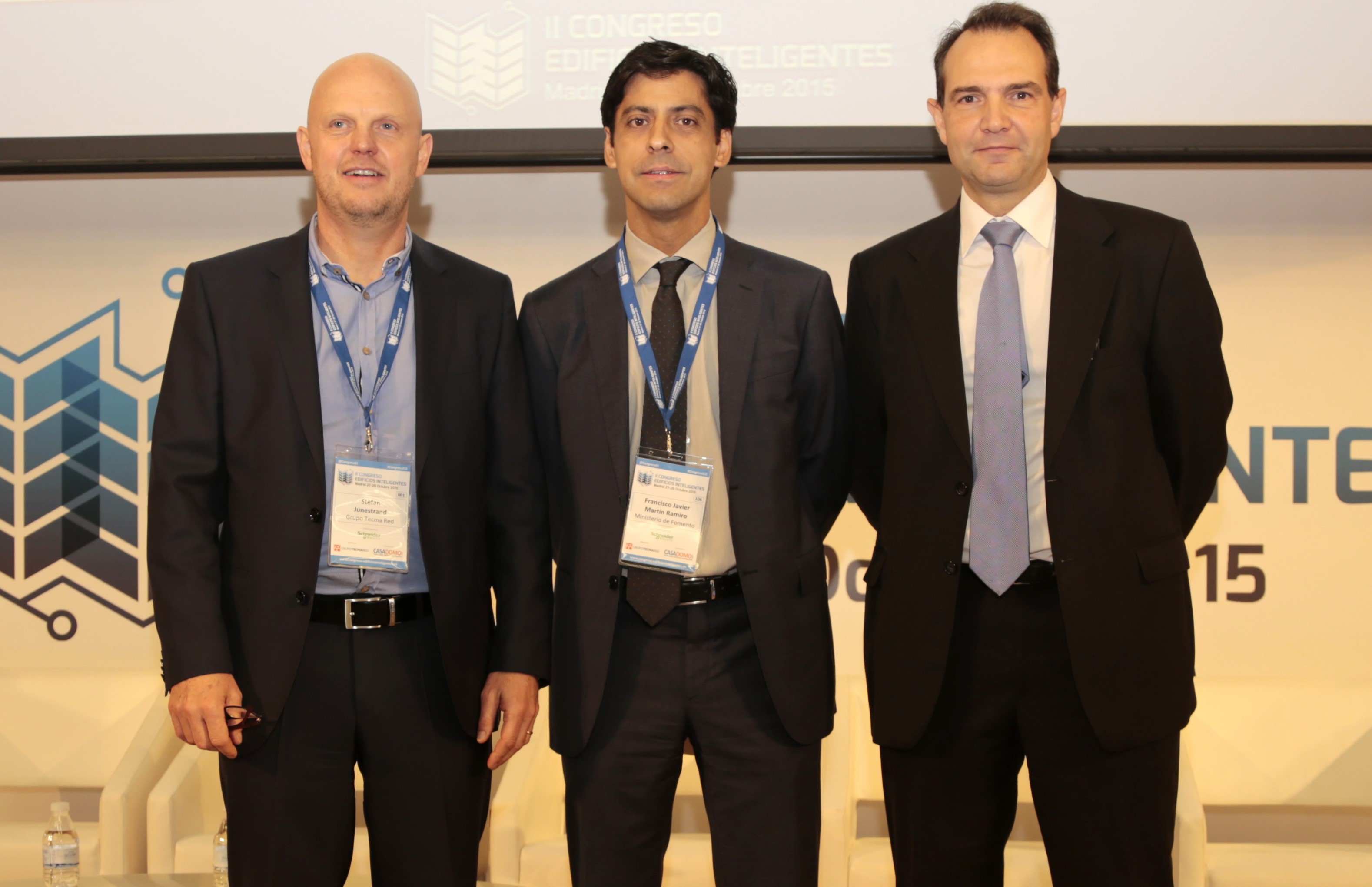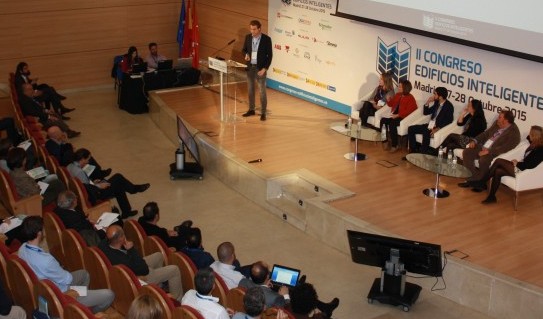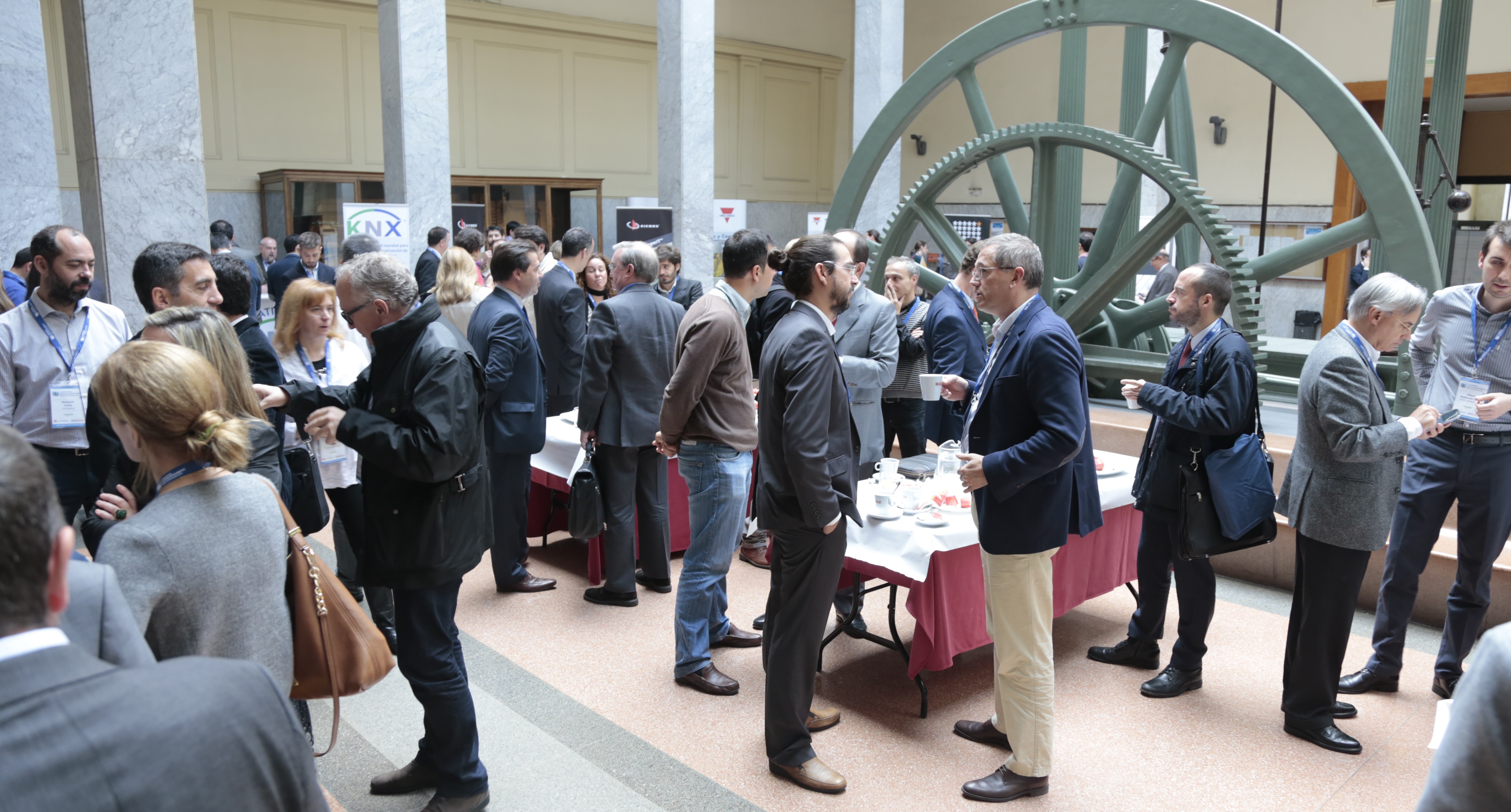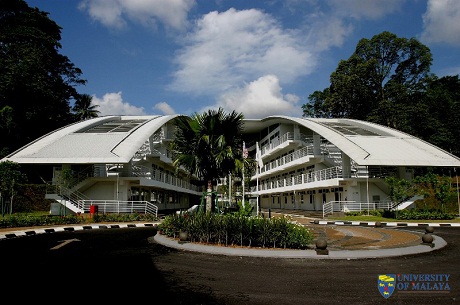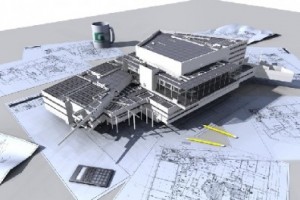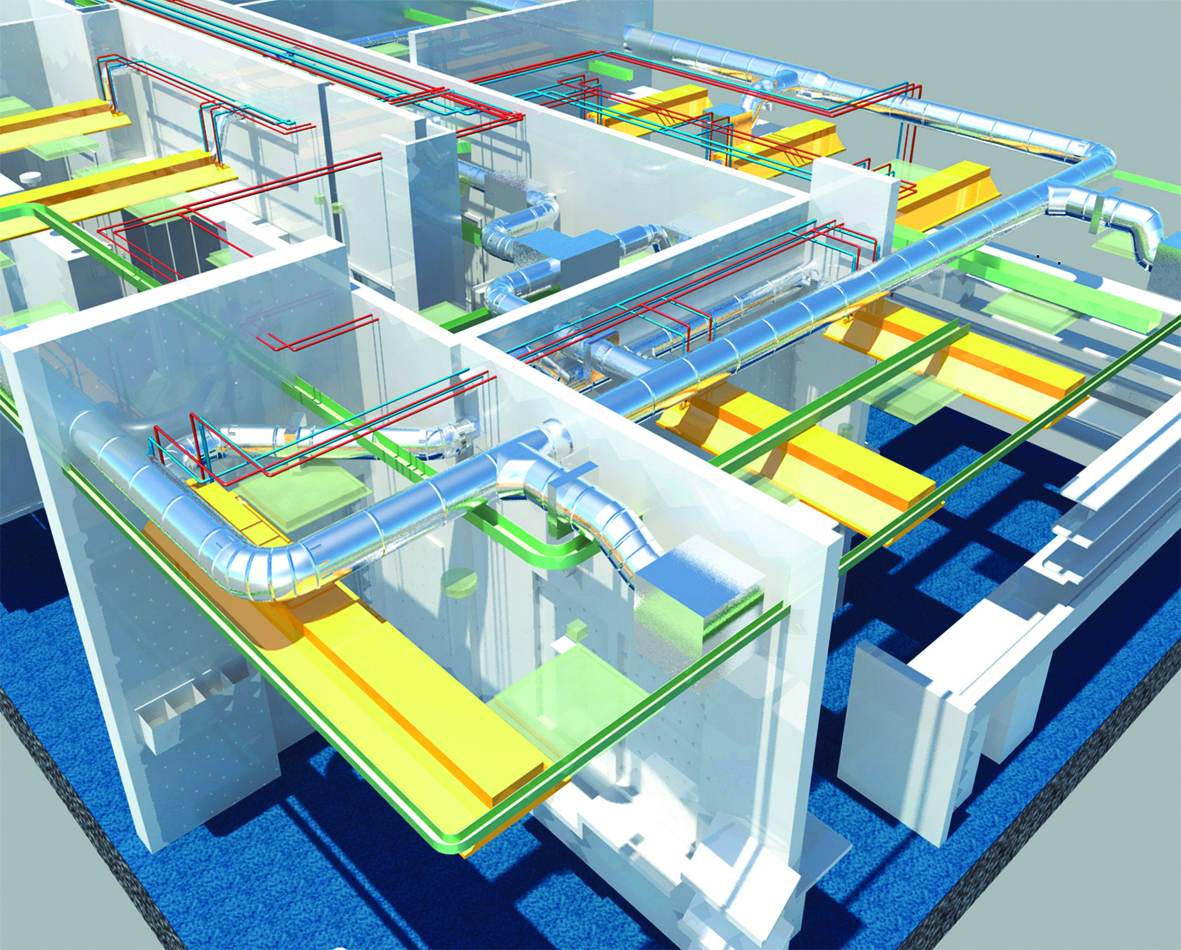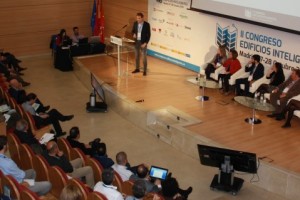
The 2nd Congress for Intelligent Buildings (II Congreso Edificios Inteligentes) brings together more than 200 professionals to expose and discuss the Intelligent Buildings in Spain
More than 200 practitioners participated in the 2nd Congress for Intelligent Buildings (II Congreso Edificos Inteligentes) – www.congress-edificiosinteligentes.es – which took place in Madrid from 27th to 28th October. The congress is the main event that is organised on a national level to discuss the different aspects that defines from a multidisciplinary point of view the Intelligent Buildings in Spain.
The Congress was held in the Hall of the Escuela Técnica Superior de Ingenieros Industriales de Madrid, Universidad Politécnica de Madrid, and, in the entrance of the hall, assistants were able to visit the meeting points of the sponsors.
In the congress, it has been able to observe a growing interest in solutions for intelligent buildings, which coincides with the improvement of the real estate sector, by understanding that any building of the future has to be intelligent in order to meet the growing demands of aspects such as energy efficiency, safety, and accessibility. This context represents for the companies and the sector professionals a great technological and strategic challenge, and, at the same time, it presents increasing opportunities for business solutions for automation and control, security, data networks, access control, etc.
Programme
The event was inaugurated by Francisco Javier Martin Ramiro, Architecture and Building Deputy Director, Architecture, Housing and Land Director, Ministry of Development of Spain; Oscar García Suárez, Deputy Director of Research, Doctorates and relationships with companies, Escuela Técnica Superior Ingenieros Industriales/UPM and Stefan Junestrand, Director of the Congress for Intelligent Buildings and General Director of the Grupo TECMA Red, the company which organizes the Congress.
Then it took place a Keynote Speech on smart office buildings, office and flexible working model with the case study of the new Microsoft offices in Madrid, by Fernando Rams, Director of buildings and facilities of Microsoft Spain and Portugal.
Later, it began the presentations of the Communications Block 1, with Marga Rodriguez as moderator, Manager, ENERAGEN. This block included the participation of Daniel Encinas Martín, Agencia Extremeña Energía, Guillermo Quintana of Ericsson Iberia, Javier García López, Universidad de Sevilla, and Sergio Rojas Vargas, Founding Partner of SmartBusiness.
After a break for coffee, there was a round-table discussion moderated by David Martinez, IFMA Spain, and in which there was a discussion about “The intelligence of the building as real estate values”, in which the following participants contributed with their expertise: Luis Vega Catalán, Ministry of Development; Fernando Moliner, ASPRIMA; Benjamin Eceiza, CAF MADRID; Lola Ripollés, Retail Design Institute and Coralía Pino López, ITH.
Then, the presentations of Communications Block 2, moderated by Juan Layda, CGCOII, included the participation of Abigail Rocasolano, Johnson Controls; Luis María Sánchez García, Grupo Simec Energy; César Serna, Sedical; Marc Aznar Soler, COIT and David Sanchez Redondo, Schneider Electric.
After lunch, it took place Communications Block 3, with the participants: Jaime Martín Pascual, Ferrovial Services; Susana Rodríguez Castillo, Hager Sistemas; Raúl Vacas, Merit Lilin Spain; Marta Martínez-Orozco, SIEMON; Júlio Giménez, Zennio, and Norena Martín-Dorta, University de La Laguna, and moderated by Paloma Velasco Merino, Executive Director, AES.
The session on the first day ended with a Round Table on “Usability and Accessibility in Intelligent Buildings” moderated by Manuel Leira, Madrid Think Tank, in which had the participation of Miguel Ángel Valero Duboy, CEAPAT-IMSERSO, Ministry of Health, Social Services and Equality; Juan Luís Quincoces Salas, CENTAC; José Luís Posada, Ministry of Development; Carlos Sanz, Asociación DATO and Carmen Fernández Hernández, Fundación ONCE.
October 28th, the second day of Congress, began with a Keynote Adress by José González, Vice President, BuildingSMART Spanish Chapter, who spoke about the BIM technology from the perspective of the Intelligent Building.
Then, it started the Communications Block 4, which was moderated by Jose Javier Medina Muñoz, President of the Spanish National Committee of FEANI and Dean, President of the COGITT-AEGITT; this block had the participation of: Belén Gómez, Uribarri, Acciona Infraestructuras; Félix Larrinaga, Mondragon Unibertsitatea; Juan Ignacio García García, Sistrol; José Carlos Pérez Martín, Industrial Engineer PhD. and José Manuel Olaizola Martija, TECNALIA.
After a pause, the Congress continued with a Round Table about “Internet of Things – Opportunities and Trends in Smart Buildings”, which was moderated by Stefan Junestrand, Director of the 2nd Congress for Intelligent Buildings, Grupo Tecma Red. With the participation of: Miguel Roser, President of Área de Actuación Hogar Digital, AMETIC; Adolfo Sanz, President, ASHRAE Spain Chapter; Álvaro Mallol, President of KNX Spain; Alfredo Lozano, AEDICI and Sergio Rojas, CEDIA Spain.
The morning proceed with Block 5 of Presentations, moderated by Gloria Gómez, Architecture PhD. , CSCAE, with the participation of: Ramón Ruíz-Cuevas Peña, Estudio Arquitectura Luz y Espacio; Sergio Colado García, Nechi Group; Albert López, Somfy Spain; Jofre Ayala Mayorga, Johnson Controls and José Luís Hernández, Cartif Foundation.
The Congress was closed by Fernando Herrero Acebes, Deputy Director General of Economic Promotion and Intelligent City, Madrid Town Hall, who outlined the value of the congress to empower Madrid as a city committed to technological advances, and Stefan Junestrand, Director 2nd Congress for Intelligent Buildings, Grupo Tecma Red, which greatly appreciate the quality of the contents of the congress and its good reception.
The organization and the congressmen were also very active on Twitter throughout the celebration of the Congress with more than 500 tweets related to the topic via the account @CongresoEI and the hashtag #CongresoEI2. The activity on Twitter could be followed in real time in the congress main screen.
Collaborators and Sponsors
Gold Sponsor: Schneider Electric
Silver sponsors: Hager, Johnson Controls, Lilin, Siemon and Zennio
Bronze Sponsors: ABB, Carlo Gavazzi, Ingenium, KNX Spain, MP Ascensores and Somfy
Institutional Support: Ministry of Development (through its Architecture, Housing and Land Director); Madrid Town Hall; Ministry of Economy and Competitiveness (through its Innovation and Competitiveness Director); Ministry of Health, Social Services and Equality (via IMSERSO CEAPAT); Ministry of Industry, Energy and Tourism (through the SETSI – Secretary of State for Telecommunications and Information Society).
Collaborators: a3e, ADHAC, AEDICI, AEDIP, AES, AETIR, AFBEL, AFEC, AFME, ALI, AMETIC, AMI, ANERR, ANILED, AOTEC, APTE, ASHRAE Spain Chapter, ASIT, ASPRIMA, AVS, BREEAM.ES, Building Smart Spanish Chapter, CAF Madrid, CARTIF, CCII, CEDINT-UPM, CEDOM, CENTAC, CNI, COGITT-AEGITT, COIT, CONAIF, CGCOII, CSCAE, DOMOTYS, EMVS, ENACE, ENERAGEN, ENERGYLAB, ETSII-UPM, F2E, F2I2, FECOTEL, FENIE, FENITEL, IFMA, IMDEA, ITH, KNX España, Lonmark España, Madrid Network, MDHD-UPM, PLANETIC, Fundación Sta. María la Real, SECARTYS, SmartLivingPlat, TECNALIA, Instituto CC. Eduardo Torroja, ETSE-Universitat de València and WIRE.












